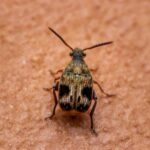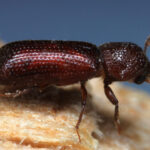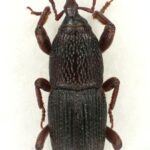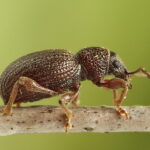Why correct pest identification matters in food facilities
In food processing, storage, and distribution, the smallest pest can have the biggest impact. Among the most commonly misidentified pests are “weevils.” Operators often report seeing “weevils” in grains or dry goods, but not every small brown beetle is truly a weevil. Understanding what separates an actual weevils from their lookalikes is key to protecting product integrity and maintaining audit-ready conditions.
What Defines a True Weevil
True weevil belong to the beetle family Curculionidae, one of the largest animal families on earth. They’re easy to recognize once you know what to look for:
- A distinct elongated snout (rostrum) used to feed and lay eggs.
- Elbowed antennae that attach partway down the snout.
- Larvae that typically develop inside seeds or kernels.
In short: all weevils are beetles, but not all beetles found in stored products are weevils.
This distinction matters because pest behavior, life cycle, and preferred treatment vary widely between true weevils and other stored-product beetles.
Common Misidentifications in Food Facilities
Because they share similar size, color, and habitat, several pests are frequently mistaken for weevils. Correct identification ensures your pest management plan targets the right species.
Cowpea Weevil (Callosobruchus maculatus)

Cowpea Weevil. Photo courtesy of iNaturalist https://www.inaturalist.org/photos/178165497
Despite its name, this insect isn’t a weevil. The cowpea weevil lacks the characteristic snout of true weevils and infests beans, peas, and other legumes. It’s often introduced through infested raw commodities.
Lesser Grain Borer (Rhyzopertha dominica) and CigaretteBeetle (Lasioderma serricorne)

Lesser Grain Borer. Photo courtesy of iNaturalist https://www.inaturalist.org/photos/356297069
These small beetles attack a wide variety of stored products preferring decaying grains like flour, cereal, spices, and tobacco.
They’re often mistaken for weevils due to their size and behavior but require different control strategies focused on sanitation, monitoring, and commodity turnover.
Sawtoothed Grain Beetle (Oryzaephilus surinamensis)

Sawtootheed Grain Beetle. Photo courtesy of iNaturalist https://www.inaturalist.org/photos/109201268
Flat-bodied and fast-moving, these beetles thrive in processed foods like oats, cereals, and packaged goods. Unlike true weevils, they cannot develop inside whole kernels.
True Weevils in Stored Products
Two species are true “weevils” of concern to the food industry:
- Granary or Wheat Weevil (Sitophilus granarius): Infests stored grains and cannot fly, making it primarily a storage pest.

Granary Weevil. Photo courtesy of iNaturalist https://www.inaturalist.org/photos/696635
- Rice Weevil (Sitophilus oryzae): Similar in appearance but capable of flight, spreading infestations quickly between areas or storage bins. They also have 4 reddish/yellowish colored spots on their wings.

Rice Weevil. Photo courtesy of iNaturalist https://www.inaturalist.org/photos/174114397
Both species lay eggs inside whole grains, where larvae develop unseen, hollowing out the kernels from within. This causes product contamination and loss that may only be discovered during inspection or processing.
Weevils Beyond Stored Commodities

Strawberry Root Weevil. Courtesy of iNaturalist: https://www.inaturalist.org/photos/166781719
Not all weevils threaten dry goods. Some target live plants and root systems, such as the Strawberry Root Weevil (Otiorhynchus ovatus), which damages field crops and ornamental plants. While not a facility pest, it highlights the diversity of the weevil group and the importance of species-level identification in agricultural environments.
Figure 7 Strawberry Root Weevil. Courtesy of iNaturalist: https://www.inaturalist.org/photos/166781719
Why Proper Identification Matters
In a regulated environment, misidentification can lead to ineffective treatments, recurring infestations, and audit risk.
- Treatment Approach: True weevils may require commodity fumigation or grain turnover, while other beetles may be managed through exclusion and sanitation.
- Root Cause Analysis: Knowing the species helps trace the source—whether from incoming commodities, packaging materials, or residual product buildup.
- Regulatory Compliance: Accurate records and proactive responses support compliance with FDA, FSMA, and third-party audit standards.
Partnering for Precision Pest Management
Sprague’s entomologists and food industry specialists are trained to distinguish between weevils and their look-alikes, provide species-level identification, and tailored control strategies. From raw commodity storage to packaged product handling, accurate identification helps protect your facility’s reputation, product safety, and bottom line.

